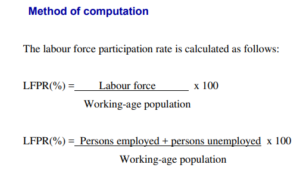In news–Government has recently refuted media claims of a decrease in the Labour Force Participation Rate (LFPR) by citing official data.
What is the issue?
- Quoting a private research firm, many media houses reported on April 25 that millions of Indians, especially women have quit their search for jobs because of dearth of opportunities in the past five years.
- Private media said millions are exiting the labour force and from 2017 to 2022, the overall labour participation rate dropped from 46% to 40%
- In its reply to the media, Centre reminded that a substantial portion of the working age population is either pursuing education (secondary/ higher/ technical education) or engaged in unpaid activities like production of goods for own consumption, unpaid domestic activities or caregiving services for household members, volunteering, training, etc.
- Government said that more than 10 crore people were enrolled in Secondary, Higher Secondary, Higher or Technical education during 2019-20 out of which, about 49% were female.
- Citing latest annual PLFS report of 2019-20, government pointed out that the Labour Force and Work Force in the country has increased steadily during 2017-18 to 2019-20 and on the other hand Unemployment Rate has declined.
What is the Labour Force Participation Rate (LFPR)?
- It is the percentage of the population which is either working (employed) or seeking for work (unemployed).
- According to the International Labour Organisation (ILO), the LFPR is a ‘measure of the proportion of a country’s working-age population that engages actively in the labour market, either by working or looking for work’.

- The breakdown of the labour force (formerly known as economically active population) by sex and age group gives a profile of the distribution of the labour force within a country.
Following are the various sources that give data on job creation in India:
Periodic Labour Force Survey(PLFS):
- The Labour Force participation Rate (LFPR), Worker Population Ratio (WPR) and Unemployment Rate (UR) in usual status for persons of age 15 years and above were 46.8 percent, 49.8 percent and 6 percent respectively in 2017-2018.
- Worker Population Ratio (WPR) is defined as the percentage of employed persons in the population.
- LFPR and WPR increased to 50.9 and 53.5 in 2019-20, and the unemployment rate dipped to 4.8 percent.
- PLFS data also shows that the increase in female labour force as well as female worker population ratio during 2017-18 to 2019-20 is higher compared to increase in male labour force & worker population ratio.
- The quarterly labour force data indicates that though the Labour Force declined during the 1st wave of Covid-19 pandemic, however, with the revival of economy in the subsequent quarters of 2020-21, the labour force showed a swift recovery.
Economic Survey 2021-22:
- The survey estimates also indicate an increase of 4.75 crore in employment during 2019-20 compared to 2018-19.
- The increase in labour force during 2019-20 compared to previous year was 4.52 crore. Thus, during 2019-20, more employment was generated than the increase in the labour force in the country.
Quarterly Employment Survey (QES):
- QES conducted by the Labour Bureau, aims to assess employment situations in respect of selected nine sectors of the non-farm economy of India over successive quarters.
- The estimated total employment in the nine selected sectors in the second round of QES (July-September, 2021) came out as 3.10 crore approximately, which is 2 lakhs higher than the estimated employment (3.08 crore) from the first round of QES (April-June, 2021).
Employees’ Provident Fund Organisation (EPFO) Payroll Data:
- This data covers the low paid workers in medium and large establishments of the formal sector.
- Latest payroll data released by EPFO on 20 April 2022 shows that there is net addition in EPF subscribers of 14.12 lakh in the month of February 2022.
- Further, the latest net payroll data reflects that the net addition in EPF subscribers has increased by 44% during 2021-22 (up to Feb, 2022) compared to the year 2020-21.
















